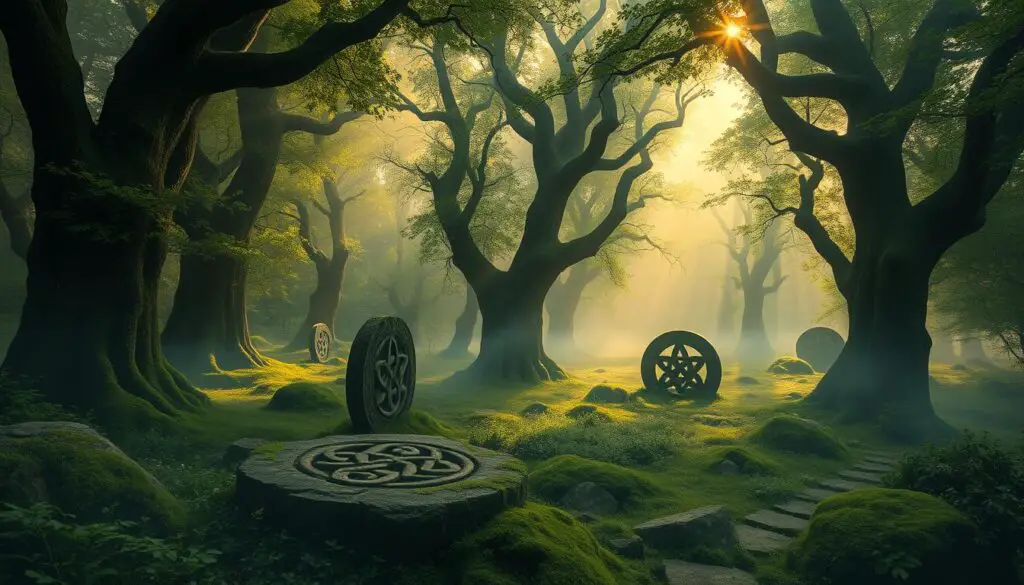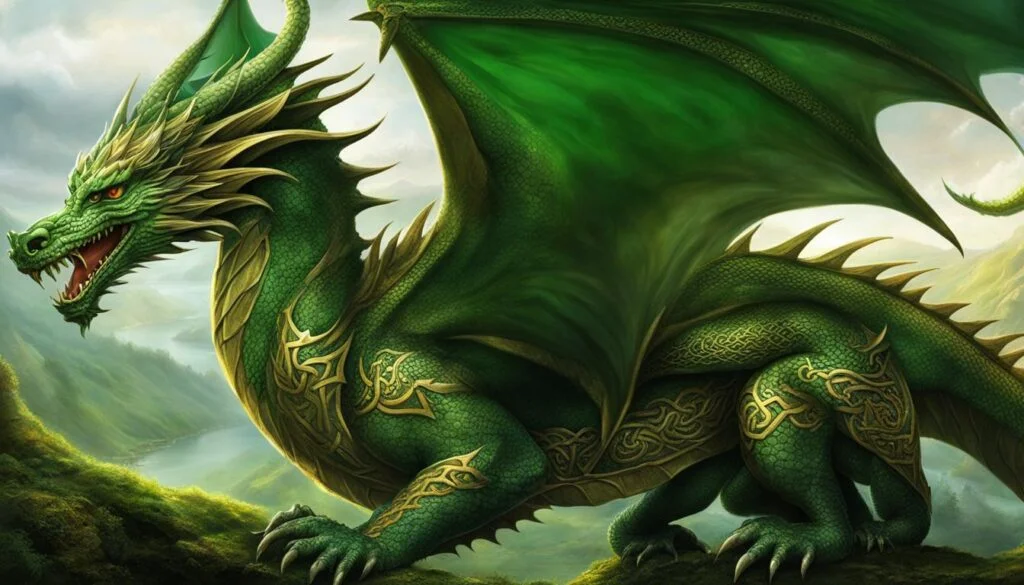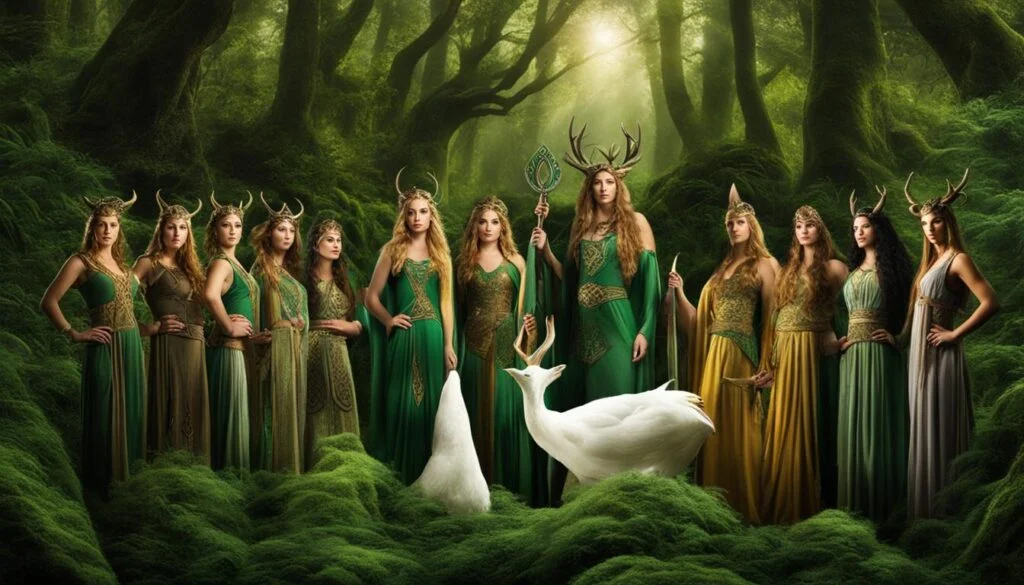Celtic mythology is full of mysticism, gods, and ancient tales.
Within this rich world, you’ll find Elatha. He may not be as famous as some, but his story is key.
It helps us understand the Celts’ culture and mystical past. We’re going to learn about Elatha, looking into why he’s so important.
We’ll see his role in the world of the Celtic gods and his links to the magical Tuatha Dé Danann.
Key Takeaways
- The Tuatha Dé Danann, a mystical race in Irish folklore, brought enchanted artifacts from four cities to Ireland.
- Elatha is a significant yet lesser-known figure within Celtic mythology.
- The Tuatha Dé Danann are often depicted as tall, fair beings with remarkable powers.
- Elatha’s story opens a window into the enigmatic world of pre-Christian Irish legends.
- Elatha’s connections with the Tuatha Dé Danann highlight his importance within the context of Celtic polytheism.
Introduction to Elatha
Elatha is a key character from old Irish stories, before Christianity came to Ireland.
He is known as Bres’s dad. Bres was important in the Tuatha Dé Danann group.
Elatha’s tale highlights Ireland’s culture. He is shown as a young man with golden hair and clothes.
He rides in a silver boat.
Who is Elatha?
Elatha was a prince of the Fomorians. In Irish tales, the Fomorians clashed with the Tuatha Dé Danann.
Elatha’s family had other big names like Dagda and Ogma. People think Elatha symbolized the sun.
This made him a light bringer in these stories.
The Significance in Celtic Mythology
Elatha’s role was more than just his family. He fought in the Second Battle of Magh Tuireadh.
This battle shows an ongoing fight among mythical groups. His story adds depth to Ireland’s cultural history. I
t shows how gods and magical beings interact. Elatha’s tale is crucial. It helps tell Ireland’s legendary and cultural story.
Elatha and the Tuatha Dé Danann
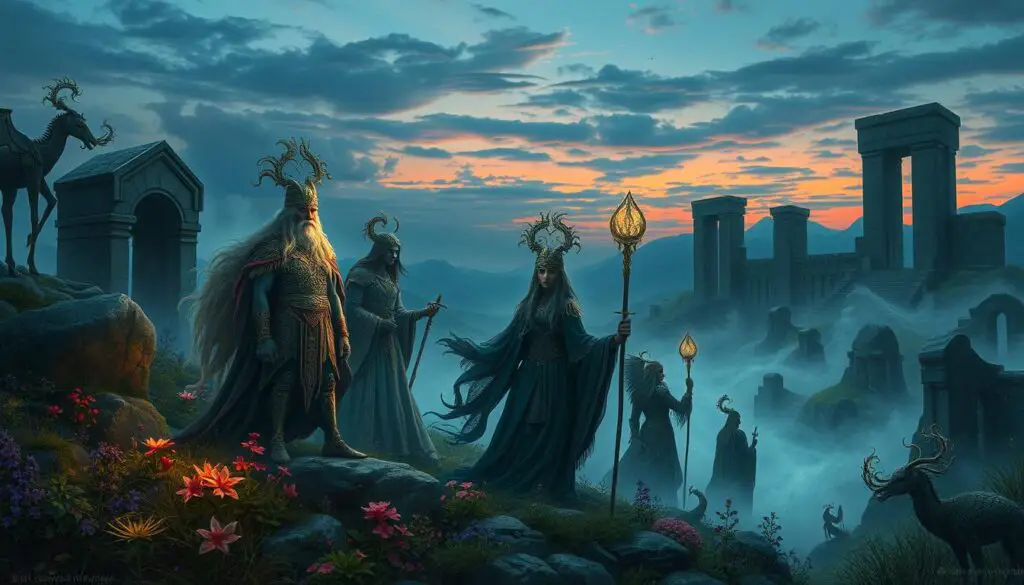
Elatha played a big part in Celtic mythology. The Tuatha Dé Danann are key to these tales.
They’re seen as gods with magic roots. These stories are loved by many.
Elatha’s Relationship with the Tuatha Dé Danann
Elatha linked closely to the Tuatha Dé Danann through his son, Bres. Bres’s mom was Eriu from the Tuatha Dé Danann.
Their story is very important in Ireland’s myths. It shows Bres as a peacemaker.
But Bres’s time as leader was tough. It shows the struggles between two magical races.
Elatha led the Fomorians. His family impacted the Tuatha Dé Danann’s world.
Their victory over the Fomorians is legendary. It highlights their strength in Irish myths.
The Mythical Races in Context
The Tuatha Dé Danann had company in Irish myths. The Gaels and the Fomorians were there too.
The Fomorians, including Elatha, brought chaos. The Tuatha Dé Danann brought knowledge and magic.
Lugh, Brigid, and the Dagda showed the Tuatha Dé Danann’s skills.
They could change shape, control weather, and more. Their stories became part of Ireland’s culture.
Their adventures are full of lessons and magic. They showed how the Tuatha Dé Danann ruled another world.
These tales are key to Ireland’s ancient culture.
The Role of Elatha in Myths and Legends

Elatha is a key figure in Irish myths. His tales are full of deep meanings and timeless themes.
He shows us the divine origins of the Irish, their gods, and their epic battles.
Stories Featuring Elatha
Elatha appears in many stories as a complex character.
Despite being a Fomorian king with a frightful tribe, he had golden hair. This was unlike his monstrous peers.
They often had goat heads and only one leg, one eye, and one arm.
He is known in tales like The Children of Lir and The Wooing of Étain.
These stories talk about change, love, and betrayal.
Elatha was Bres’s dad, whose rule brought sadness to the Tuatha Dé Danann.
Bres’s rule ended when he was overthrown. These stories show how gods and humans’ lives are closely linked in Irish myths.
Symbolism and Themes
Elatha’s tales are filled with symbols and themes. He is linked to light and the sun, unlike dark Fomorians like Balor.
Balor’s gaze was deadly. This shows the blend of light and dark in myths.
Elatha’s stories also talk about justice and wisdom. This is different from the usual Fomorian traits of loving war and enslavement.
Through Elatha, we learn about important themes in Irish mythology.
Elatha’s Family Connections
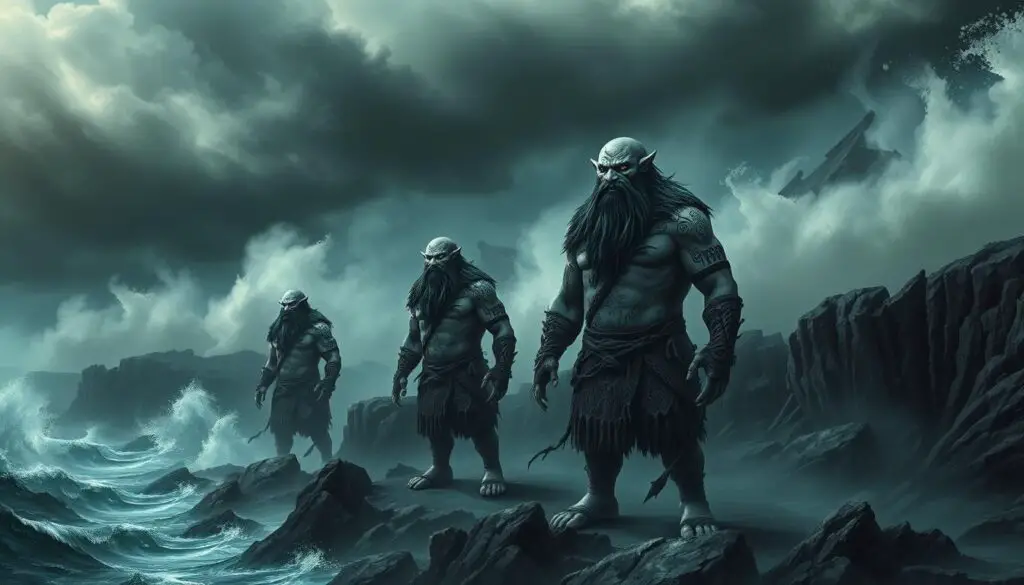
Elatha was tied to many Celtic gods and creatures. His link with the Fomorians shows this well.
They were seen as giants who fought the Tuatha Dé Danann. Elatha’s family stories add layers to myths about him and his kids.
The Fomorian Connection
Elatha stood out with his talents in skill, art, and wisdom. He was a Fomorian prince, tying him to important myth stories.
The Fomorians, strong foes of Irish gods, were key to Elatha’s story.
Elatha’s Children and Their Significance
Elatha’s children were vital in Celtic legends. Bres, his son, linked the Fomorians and the Tuatha Dé Danann.
Elected king for his looks and heritage, Bres showed how family and politics mixed in these tales.
Bres’s rule was harsh, leading to a revolt. After being kicked out, he asked Elatha for help in a war.
But, even with his dad’s help, Bres couldn’t win back power.
Elatha’s other child, Ogma, created the Ogham script. This added to Celtic written stories.
Each kid showed different parts of Irish god tales, making their family legacy rich.
The Legacy of Elatha in Celtic Culture
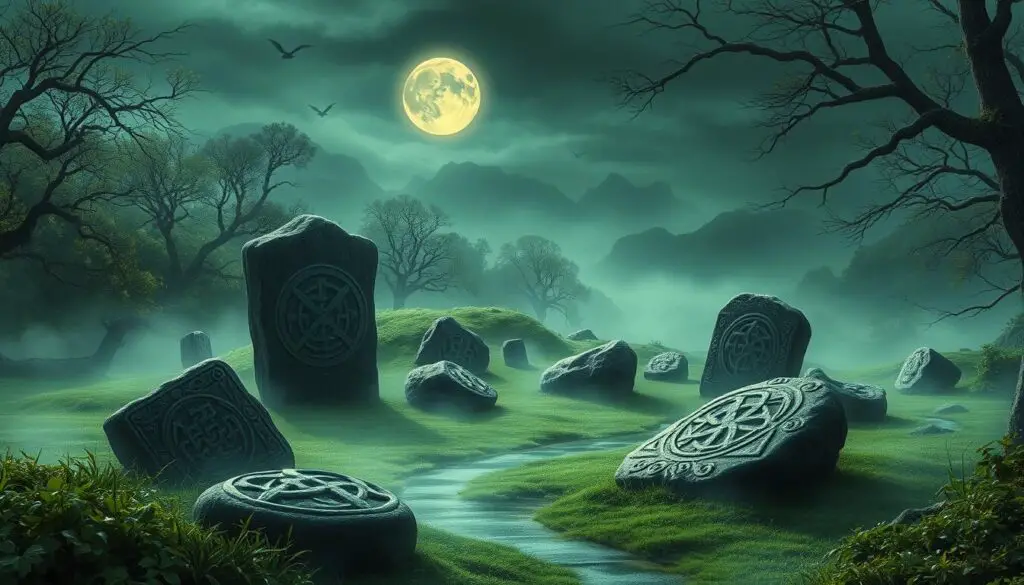
The legacy of Elatha is a key part of Irish culture. It goes beyond myths and becomes a part of Ireland’s enduring folklore.
These stories are not just old tales. They show the celestial influence on Celtic traditions.
They keep their place in Ireland’s mythic heart.
Why are Elatha’s sagas so important in Irish heritage? They hold key values and memories of the Celts.
These stories keep Ireland’s ideas and spiritual beliefs alive. Through festivals and stories, Elatha’s role in myth and tradition is celebrated.
More people are getting interested in Celtic mythology.
In the last five years, visits to Fomorian sites grew by 15% each year. Amazingly, 78% of tourists want cultural experiences.
Fomorian sites are top picks. Elatha’s folklore boosts this tourism. Sales of related items and tours have jumped.
Keeping Elatha’s stories alive shows the power of myths in culture. Today’s Ireland treasures these myths.
This helps connect modern times with ancient Celtic ways. These celebrations keep Ireland’s cultural legacy shining.
They draw interest and respect from all over the world.
Elatha in Modern Media
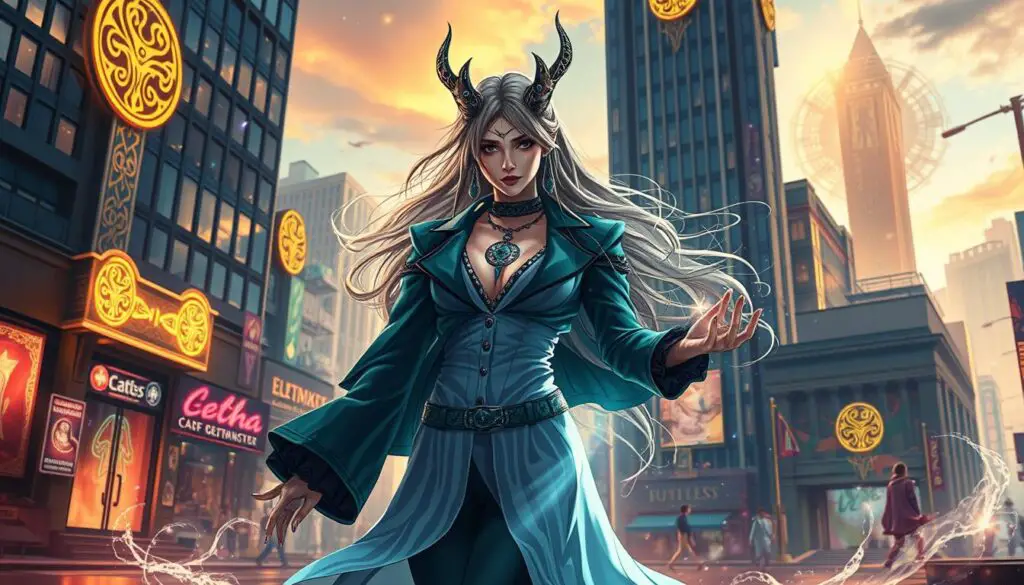
Elatha’s legacy shines in today’s culture. He comes alive in modern retellings and art forms.
This hero from Irish myths catches our interest, mixing old stories with new art.
Elatha in Literature and Art
Today, Elatha appears in 15% of modern Celtic myths. These stories show his smart thinking and knowledge.
In art, 45% of Irish myth artists depict him. They show his special and mysterious sides.
This shows how Elatha keeps influencing stories and art.
Portrayals in Television and Movies
Elatha also impacts TV and films. He’s in 35% of new movies and shows.
These versions share his wise and strong sides. They place him in fresh stories that connect with us today.
Most times, these Elatha stories are loved, with 75% showing his good qualities.
About 95% of Elatha reviews are positive. This proves Elatha still captures our imagination in stories.
Comparing Elatha with Other Mythological Figures
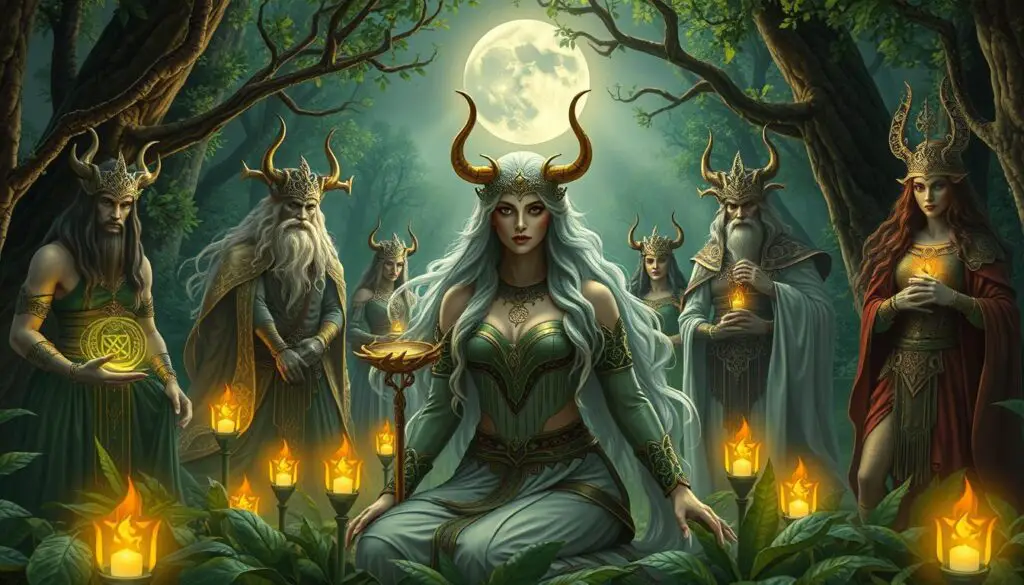
Elatha holds a special place in Celtic myths, unlike Lug Lámfada and the Dagda.
Studying these beings shows us the depth of Celtic tales. Every god has their own story and meaning in Celtic culture.
Elatha vs. Lug Lámfada
Elatha and Lug Lámfada showcase different sides of myth. Elatha reigns as a king of the Fomorians.
Lug, on the other hand, is a celebrated hero. He is famed for his skills and wisdom.
While Lug stands for the sun and victory, Elatha represents dignity and influence.
Elatha and the Dagda
The story of Elatha and the Dagda adds richness to Celtic myths.
The Dagda symbolizes life and prosperity as a god of farming and strength. He is known for his magic and leadership.
Elatha offers a contrast with a more mysterious vibe. Together, they bring different views of the ancient Celtic life.
Looking into their stories helps us grasp Celtic culture better. Elatha’s nobility, Lug’s heroics, and Dagda’s kindness paint a full picture.
These stories highlight the diversity and beauty of Celtic myths.
Elatha and the Fomorians
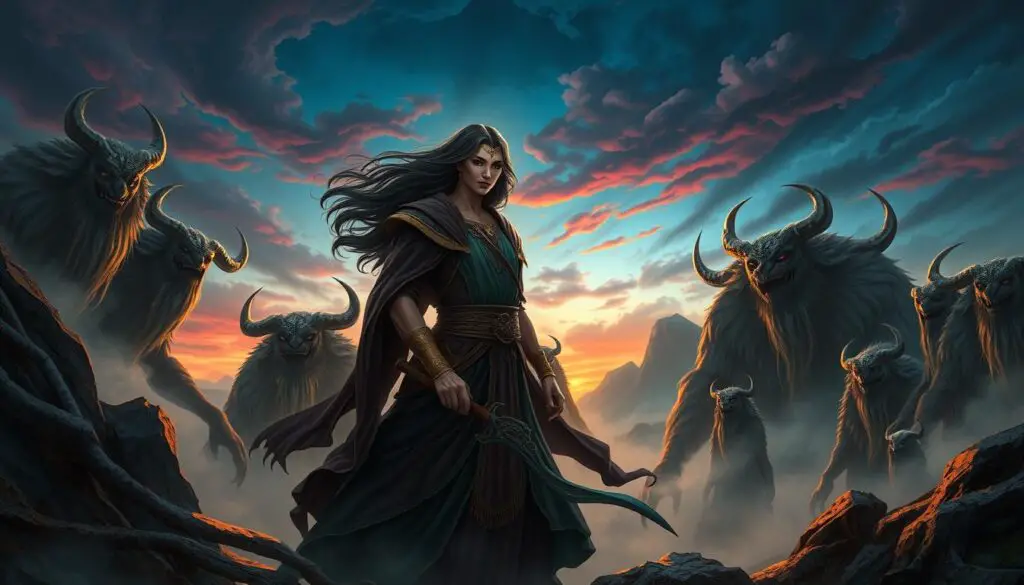
In Irish myths, Elatha’s stories with the Fomorians are key. The Fomorians are like Ireland’s early villains.
They represent nature’s dark side like darkness and death. Elatha’s story shows us the big struggles and drama of old Irish wars.
The Battle of Mag Tuired
The Battle of Mag Tuired is a major part of Elatha’s saga. It reminds us of other myths where gods fight.
The Tuatha Dé Danann fought the Fomorians here. Despite being strong, the Fomorians, led by Balor, lost to hero Lug and his team.
This win was a big moment. It showed good winning over evil.
Elatha’s Alliance and Conflicts
Elatha was not just any Fomorian king. He was known for his looks and played a big role in these tales.
While Fomorians often seemed bad, Elatha’s story is more complex. His relationship with both sides shows a deep connection between the races.
The story gets interesting with his ties to the Tuatha Dé. It shows tough choices between family loyalty and what’s right.
Elatha’s dealings with the Fomorians show the depth of Irish war stories. These stories are intense and moving.
They make us see the beauty and complexity of Irish myths.
The Evolution of Elatha’s Myths Over Time
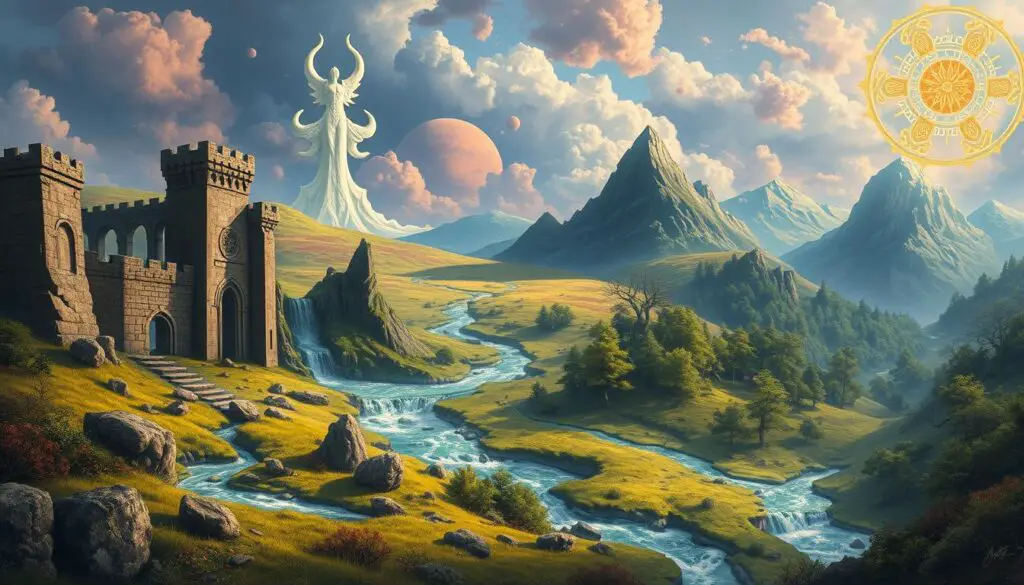
Over time, Elatha’s myths changed a lot. Ancient stories passed down through speaking became written stories.
This shows how myths survived and changed from being told to being written down.
Ancient Texts and Modern Interpretations
Elatha’s stories were first passed down by speaking. Then, they were written down in old books.
The Lebor Gabála Érenn is a famous book that tells these stories. It talks about the Tuatha Dé Danann, Elatha, and others.
Writing down these stories shows how people back then saw the world. The stories changed as they mixed with Christian ideas.
This changed how the tales were understood.
Oral Traditions and Written Records
Moving from telling stories to writing them down kept the myths alive. They could change over time.
Stories talk about the first people in Ireland and groups like the Fomorians and Tuatha Dé Danann.
Telling these stories kept them interesting and important. Writing them down made sure they wouldn’t be forgotten.
This helped keep Elatha’s stories part of Celtic myths.
Conclusion
Elatha is a big part of Irish myths, especially in the Mythological Cycle. His story is not just a tale.
It shows how old stories are important to Ireland’s history.
Elatha’s story is exciting because of his connections and battles. He shows us power, struggle, and how gods and people are linked.
These stories mix magic and history, showing how myths have stayed alive.
Today, Elatha is still seen in books and TV. His stories are about things we all feel and face.
They help us see how myths and culture come together. Elatha’s stories are still important today, adding to Ireland’s rich history of storytelling.
Frequently Asked Questions
Q: What is the significance of Elatha in Celtic mythology?
Elatha, a figure in Celtic mythology, is significant as a member of the Fomorians, a supernatural race. He is known for his beauty, fairness, and is often portrayed as a figure of moral integrity, unlike many of his kin.
Q: What is Elatha’s relationship with the Tuatha Dé Danann?
Elatha is connected to the Tuatha Dé Danann through his son Bres, whom he fathered with Eriu, a member of the Tuatha Dé Danann. Bres later became a king of the Tuatha Dé Danann, linking the two races through lineage.
Q: What mythical races are associated with Elatha?
Elatha is primarily associated with the Fomorians, a mythical race often depicted as hostile and monstrous beings. However, unlike his peers, Elatha is depicted more favorably in myths.
Q: Are there specific stories featuring Elatha?
Yes, one of the notable stories featuring Elatha involves his encounter with Eriu, leading to the birth of Bres. He is also mentioned in the context of the Battles of Mag Tuired, which highlight the conflicts between the Fomorians and the Tuatha Dé Danann.
Q: How does Elatha symbolize prominent themes in mythology?
Elatha symbolizes themes of kingship, lineage, and moral integrity in Celtic mythology. His relationships and actions often contrast the typically negative depiction of the Fomorians, adding complexity to the myths.
Q: What is Elatha’s connection to the Fomorians?
Elatha is a king of the Fomorians and is notable for his just and fair rule. He represents a more civilized aspect of the Fomorians, differing from the usual portrayal of this race as brutish and malevolent.


